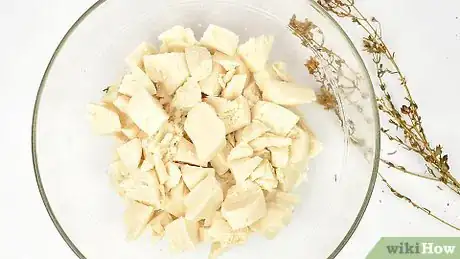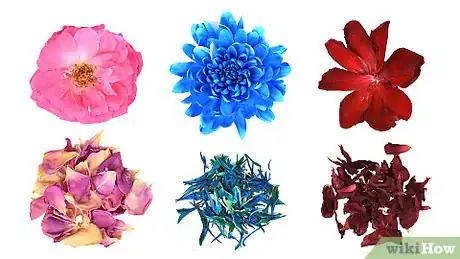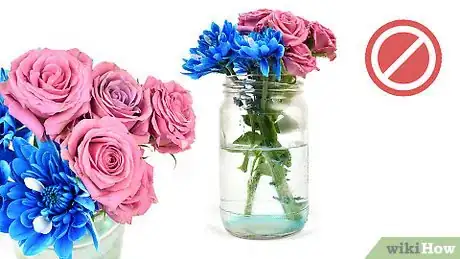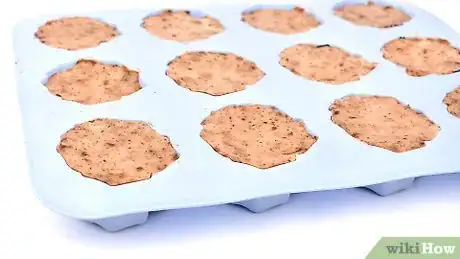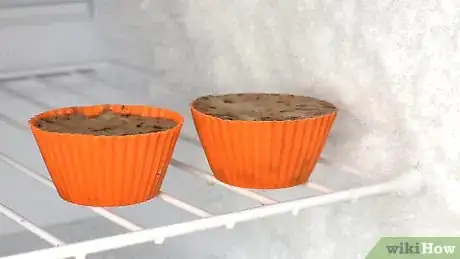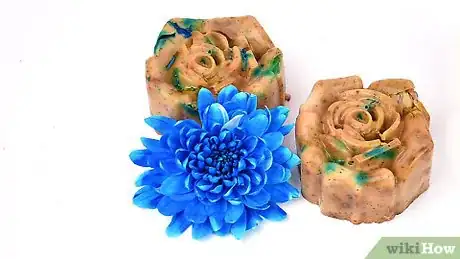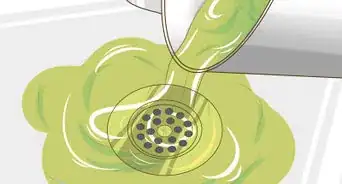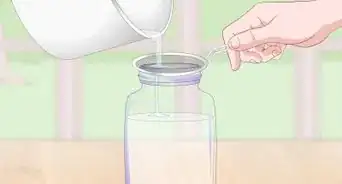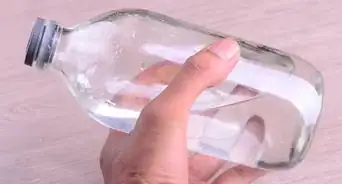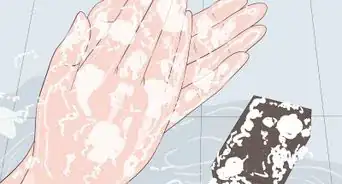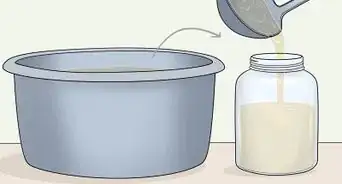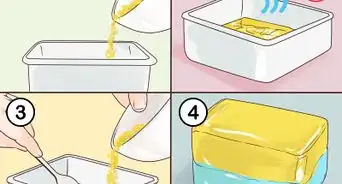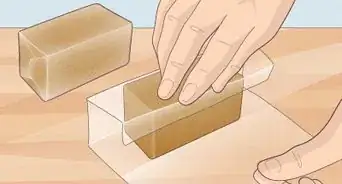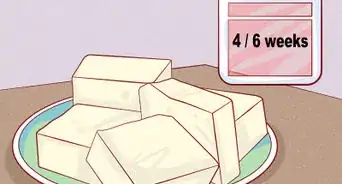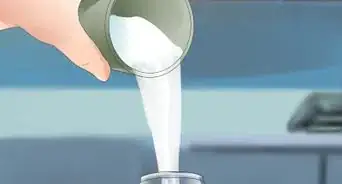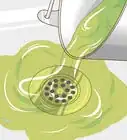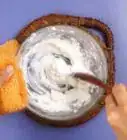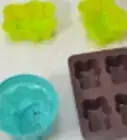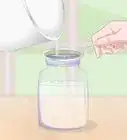This article was co-authored by Julie Brow-Polanco and by wikiHow staff writer, Jessica Gibson. Julie Brow-Polanco is a Master Herbalist & Certified Aromatherapist with more than 11 years of experience. She is an expert on natural remedies and specializes in using them to support whole-body wellness, particularly immune, digestive, nervous, and reproductive health. Julie earned a Bachelor's Degree in Psychology from Dominican University, a Master Herbalist Certification from The School of Natural Healing, and a Certificate of Aromatherapy from the Pacific Institute of Aromatherapy. Julie is a member of the American Herbalist Guild and a Certified Aromatherapist through the National Association of Holistic Aromatherapy.
This article has been viewed 147,785 times.
Adding dried herbs to homemade soap is a simple but creative way to add fragrance and beauty to an otherwise ordinary item. Start by melting down a plain glycerin soap base. Experiment with your favorite fragrances by adding essential oils. Then prepare your dried herbs, dried flower petals, and dried plant sprigs for the soap, either by grinding them into fine pieces or by arranging them decoratively within the soap molds. Be sure to use skin-safe, edible plants only, and avoid mixing any fresh plants into your soap. If you make enough bars of soap to share, you and your loved ones will feel oh so pampered!
Steps
Preparing the Soap Base
-
1Cut the block of glycerin soap into cubes or slivers. You'll make this soap with a plain glycerin soap base. Start with as much glycerin as you need to produce your desired quantity of soap bars. Use a blunt knife to chop the glycerin into 1 in (2.5 cm) pieces. Alternatively, you can use a cheese grater to grate the block into slivers.
- Smaller pieces will melt more quickly.
- For reference, 4 oz (110 g) of melted-down glycerin soap will make 3 bars of muffin-sized soap.[1]
- Glycerin soap can be found at most craft stores and online. Look in the soap making section.[2]
- Choose a suspension formula glycerin soap if you plan to add in heavier herbs and flowers.
-
2Melt down the glycerin soap in the microwave. Place the chopped up pieces of glycerin into a microwave-safe container with a pouring spout. Heat this in the microwave on 50% power for about 30 seconds. Stir the glycerin slowly using a disposable spoon and heat it again until it completely turns to liquid.[3]
- You could use a double-boiler instead, if you prefer.
- Be careful when moving the container in and out of the microwave. The glycerin will be very hot!
Advertisement -
3Stir in a few drops of essential oil to add fragrance. Add about 2 to 5 drops of an essential oil per each ounce of glycerin. Stir gently and slowly to blend the oils with the glycerin. Some air bubbles will form, but try not to push a ton of air bubbles into the liquid glycerin. Choose fragrances that complement the types of herbs you plan to add.[4]
- If you're using dried lavender, add lavender essential oils. Pair other dried herbs with other aromas, like eucalyptus, bergamot, geranium, juniper, lemongrass, rosemary, ylang-ylang, or a citrus essential oil. The possibilities are endless!
- Don't go overboard when adding essential oils. If you add too much to your soap, the essential oils will cause skin irritation.
- Your soap recipe should never contain more than 3% essential oils. Certain oils shouldn't be used for more than 1% of the soap. Do you research and, when in doubt, use less than you think you need.[5]
Adding Dried Herbs
-
1Grind up dried herbs to mix them into the liquid glycerin. Try using peppermint, parsley, sage, rosemary, thyme, or lemon balm in your handmade soap. Use a mortar and pestle to grind your dried herbs into a powder or use a small kitchen knife to mince up the herbs into very small pieces. Sprinkle the herbs into the microwavable container and use a disposable spoon to gently and slowly stir them into the glycerin.
-
2Arrange whole dried herbs in the bottom of the soap molds so they appear on top. Your soap could feature pretty sprigs of rosemary or colorful citrus peels and flower petals at the top. To make this happen, place whole dried herbs and, dried flower petals, or dried fruit peels into the bottom of your soap molds first. Lay them out in a nice arrangement before pouring the liquid glycerin on top.[8]
- If your chosen herbs or flowers have a top side, place them top-down into the molds.
- This works especially well if you start with a clear glycerin soap base.
- Try using whole sprigs of dried herbs or laying out individual leaves into a pattern.
- Avoid mixing whole herbs into the liquid glycerin. The dried leaves will rehydrate when you start using the soap, and you don't want to find yourself lathering a slimy leaf!
-
3Use only safe, edible flowers and plants in your soap. Do your research beforehand to make sure your chosen flowers are safe for soap making. A good rule of thumb is that if they're safe to eat, they're likely safe to put on your skin as well.
- Dried flower petals can look pretty in handmade soaps. Try hibiscus, rose, lavender, chamomile, goldenrod, and calendula (not to be confused with marigolds).[9]
- Try using dried plants such as eucalyptus leaves or dried citrus peels to add fragrance and color to your soap.
- Steer clear from non-edible and toxic flowers like dahlias, oleanders, foxgloves, or lily of the valley.
- If you're not sure about the safety of a particular plant, research it online or refer to a botanical safety guidebook.
-
4Refrain from adding fresh plant elements to your soap. Fresh herbs, flowers, fruits, and leaves can lead to mold and bacteria.[10] Avoid using fresh plants to keep your soap safe, sanitary, and long-lasting.
- The only plants you should try fresh are lavender, rosemary, and thyme. The leaves of these herbs are pretty dry to begin with, and they can look attractive when used whole at the top of the soap. Avoid mixing them into the liquid glycerin, though.
Setting the Soap Bars
-
1Pour the soap mixture into soap molds. Once you've either mixed the dried herbs into your liquid glycerin or arranged larger pieces in the bottom of your soap molds, you're ready to pour the liquid soap mixture into the molds. Carefully pour the liquid into a mold for each bar of soap you want to make. Fill each mold until you reach the top, and don't overfill it.
- Silicone baking cups, ice cube trays, and soap molds are the best choice since they'll easily release your finished bars of soap.
- If you're using a metal muffin tin, prepare it with a thin layer of cooking oil first.[11]
-
2Let the soap cool at room temperature for about 1 or 2 hours. Allow the soap to cool down and solidify at room temperature. Leave it to sit until the soap has hardened all the way through.[12]
- Make sure you leave the soap molds on a level surface so your soap bars don't set unevenly.
-
3Place the soap in the freezer for 30 minutes to cool it more quickly. While this isn't necessary, it can help speed up the cooling process. Once you take the soap out of the freezer it will be completely solid.[13]
-
4Remove the bars of soap from the soap molds. With silicone molds, you can carefully pop out the bars by turning the mold over and pushing them out. With metal molds, use a butter knife to loosen the side of each bar of soap and raise it up out of the mold.[14]
- Store your soap in a layer of plastic wrap or an airtight container while it's not in use. When you're using a bar of soap, keep it on a ventilated soap dish to prevent it from soaking in too much moisture.[15]
- Keep in mind that exposure to excess heat may cause your soap to have a shorter shelf life, since the glycerin base is designed to melt.
- If you've used whole dried herbs, keep an eye on them as you start to use your soap since they may rehydrate. Dispose of the whole sprigs once they come loose to prevent mold from growing.
Expert Q&A
-
QuestionWhat herbs are best for soap?
 Julie Brow-PolancoJulie Brow-Polanco is a Master Herbalist & Certified Aromatherapist with more than 11 years of experience. She is an expert on natural remedies and specializes in using them to support whole-body wellness, particularly immune, digestive, nervous, and reproductive health. Julie earned a Bachelor's Degree in Psychology from Dominican University, a Master Herbalist Certification from The School of Natural Healing, and a Certificate of Aromatherapy from the Pacific Institute of Aromatherapy. Julie is a member of the American Herbalist Guild and a Certified Aromatherapist through the National Association of Holistic Aromatherapy.
Julie Brow-PolancoJulie Brow-Polanco is a Master Herbalist & Certified Aromatherapist with more than 11 years of experience. She is an expert on natural remedies and specializes in using them to support whole-body wellness, particularly immune, digestive, nervous, and reproductive health. Julie earned a Bachelor's Degree in Psychology from Dominican University, a Master Herbalist Certification from The School of Natural Healing, and a Certificate of Aromatherapy from the Pacific Institute of Aromatherapy. Julie is a member of the American Herbalist Guild and a Certified Aromatherapist through the National Association of Holistic Aromatherapy.
Master Herbalist & Certified Aromatherapist Some great herbs that make beautiful soaps and are good for skin are: frankincense essential oil, geranium flowers and essential oil, myrrh, Irish moss, comfrey, carrot seed, and chickweed.
Some great herbs that make beautiful soaps and are good for skin are: frankincense essential oil, geranium flowers and essential oil, myrrh, Irish moss, comfrey, carrot seed, and chickweed. -
QuestionWhat herbs should I use?
 Community AnswerPersonally, I like to use oatmeal, lemon, olive oil, and almond. If you want a specifically herbal soap, I would use rosemary, chamomile, lavender, mint, etc.
Community AnswerPersonally, I like to use oatmeal, lemon, olive oil, and almond. If you want a specifically herbal soap, I would use rosemary, chamomile, lavender, mint, etc. -
QuestionCan I use glycerin soap bought from a market? How long can the soap be kept?
 Community AnswerYes, you can, as long as the glycerin soap is melt & pour. The soap can be kept for years if necessary, as long as you keep it in a sealed, moisture-free environment.
Community AnswerYes, you can, as long as the glycerin soap is melt & pour. The soap can be kept for years if necessary, as long as you keep it in a sealed, moisture-free environment.
Warnings
- Always do your research before putting something into your soap. Just because it's a natural ingredient doesn't mean it can't be harmful. Be careful about using essential oils, herbs, flowers, and other plants that may cause sensitivities and allergies.⧼thumbs_response⧽
Things You'll Need
- Plain glycerin soap
- Butter knife
- Microwave
- Microwave safe container with a pouring spout
- Essential oils (optional)
- Dried herbs, flowers, and plants
- Mortar and pestle (optional)
- Disposable spoon
- Silicone or metal soap molds
- Cooking spray (optional)
References
- ↑ https://www.hgtv.com/design/make-and-celebrate/handmade/clean-and-green-how-to-make-herbal-soap-pictures
- ↑ https://helloglow.co/diy-herb-spice-homemade-glycerin-soap/
- ↑ https://helloglow.co/diy-herb-spice-homemade-glycerin-soap/
- ↑ https://helloglow.co/diy-herb-spice-homemade-glycerin-soap/
- ↑ https://lovelygreens.com/make-soap-with-essential-oils/
- ↑ https://lovelygreens.com/guide-herbs-flowers-soap-recipes/
- ↑ https://www.hgtv.com/design/make-and-celebrate/handmade/clean-and-green-how-to-make-herbal-soap-pictures
- ↑ https://helloglow.co/diy-herb-spice-homemade-glycerin-soap/
- ↑ https://lovelygreens.com/guide-herbs-flowers-soap-recipes/
- ↑ https://lovelygreens.com/guide-herbs-flowers-soap-recipes/
- ↑ https://www.hgtv.com/design/make-and-celebrate/handmade/clean-and-green-how-to-make-herbal-soap-pictures
- ↑ https://helloglow.co/diy-herb-spice-homemade-glycerin-soap/
- ↑ https://www.hgtv.com/design/make-and-celebrate/handmade/clean-and-green-how-to-make-herbal-soap-pictures
- ↑ https://www.hgtv.com/design/make-and-celebrate/handmade/clean-and-green-how-to-make-herbal-soap-pictures
- ↑ https://oureverydaylife.com/the-best-way-to-store-glycerin-soaps-12245196.html
